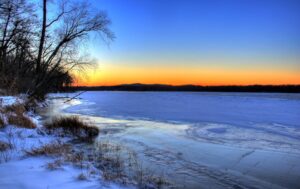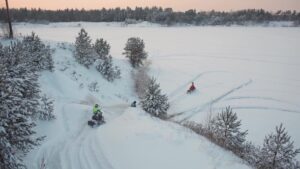An article from WWA’s Words From The Wardens.
This article originally appeared in Wisconsin Waterfowl Association’s February, 2024 eNewsletter.
 By Lt. Jacob Holsclaw, DNR Off-Highway Vehicle Administrator
By Lt. Jacob Holsclaw, DNR Off-Highway Vehicle Administrator
Wisconsin winter has flipped the script on popular seasonal outdoor fun.
After the spring-like November and December, winter roared into southern Wisconsin with two whopper January snowstorms, leaving the usual snow-packed northern counties looking brown and barren.
For some, that meant extending their seasons on the ATVs and UTVs in the north while snowmobile trails in the state’s southern counties opened to eager operators in mid-January. However, as I write this, temperatures are predicted to be above freezing and possibly fuel rain in the southern third.
 Whether you’re an ATV/UTV fan or out on the sleds, the factor of outdoor fun on off-highway vehicles that keeps me awake at night is ice. Wisconsin’s winter is marked by fluctuating temperatures. What looks like a solid ice cover may be more akin to river sandbars – forming and dissolving without warning. Ice is so unpredictable.
Whether you’re an ATV/UTV fan or out on the sleds, the factor of outdoor fun on off-highway vehicles that keeps me awake at night is ice. Wisconsin’s winter is marked by fluctuating temperatures. What looks like a solid ice cover may be more akin to river sandbars – forming and dissolving without warning. Ice is so unpredictable.
Check With Locals For Ice Status
As you know, the Wisconsin Department of Natural Resources (DNR) does not monitor ice conditions. If you are planning a snowmobile or ATV route that includes travel over a waterbody, the best advice is to try to detour around it or take the time to check the ice status with local resources to learn area ice status.
Local fishing clubs, bait shops and outfitters often have the current conditions. Some local government offices also may have information about the ice covers. The southern Wisconsin ice covers that formed during a week of polar-like temperatures may be hiding currents, debris and underground springs still feeding lakes and rivers.
Waterbody Characteristics Vary
 It’s also good to remember every waterbody has its own characteristics. As you check with local resources for ice conditions, you also can check if the lake has inlets, outlets or narrows that are spring-fed or have currents, like rivers. These factors can thin the ice.
It’s also good to remember every waterbody has its own characteristics. As you check with local resources for ice conditions, you also can check if the lake has inlets, outlets or narrows that are spring-fed or have currents, like rivers. These factors can thin the ice.
Some smaller lakes can have aerators that are run throughout the winter, either covering a large area toward the center of the lake, or may have smaller aerators placed by private property landowners adjacent to their shore and/or piers.
We at the DNR want everyone to enjoy all the seasons and your favorite activities. A main ingredient in the fun is safety. Here are a few more safety tips I’d ask you to consider if you map a route that involves a waterbody:
- Carry a cell phone and tell people where you are going and when you’ll return home.
- Wear proper clothing and equipment, including a personal flotation device or a float coat, to help you stay afloat and slow body heat loss.
- Pack extra pairs of mittens, gloves and socks so hands and feet remain dry and warm.
- Wear creepers attached to boots to prevent slipping on clear ice.
- Carry a spud bar to check the ice while walking to new areas.
- Carry a couple of ice picks and a length of light rope in an easily accessible pocket to help pull yourself – or others – out of the ice.
- Do not travel in unfamiliar areas or at night.
- Have a plan noting where you will be and when you plan to return. Along with leaving a written note of your plans, it is also recommended to keep a charged cell phone.
- If you do break through the ice, don’t panic. Turn back the way you came since the ice held your weight until that point. Attempt to pull yourself out with ice picks or assistance from another person and kick your legs. Get to a warm shelter and seek medical attention if needed.
Have fun and stay safe out there!
